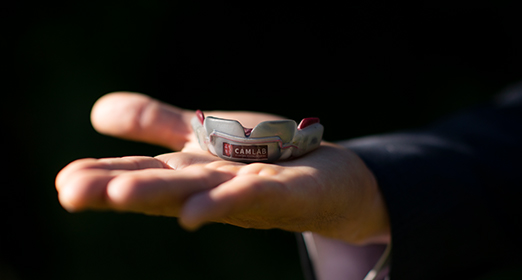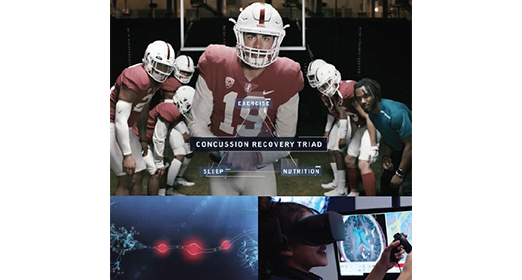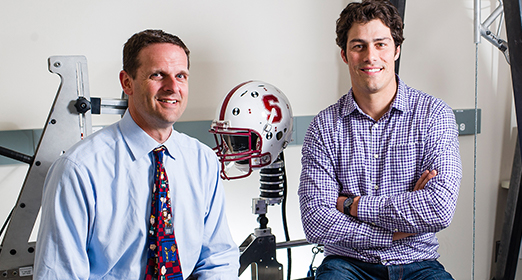Concussion experts team up to turn science into safer helmets.
“Ro-Ro, don’t forget your helmet!” calls David Camarillo, PhD, as his 4-year-old daughter, Rosie, jumps on her little turquoise bike. The training wheels wobble as she pedals away.
Parents give this same reminder to their children every day, but coming from Camarillo it has even greater significance. For the past seven years, he has studied concussions, an issue that affects approximately 2 million children each year in the United States.
“When I talk to people about concussions, they almost always think it’s a football problem,” says Camarillo, assistant professor of bioengineering at Stanford University. “But the most common cause of sports-related concussion in children? It’s bicycling.”
Notoriously hard to diagnose, many concussions go unreported. Clearance to resume activity following a concussion is often a judgment call made by a health care provider who has scant data on the injury and little expertise in brain trauma.
Overall, the science of concussions remains foggy. What causes them exactly? What happens in the brain during and after? And most importantly, how can we prevent them?
Camarillo, along with his colleague Gerald Grant, MD, FACS, Endowed Professor in Pediatric Neurosurgery at Stanford University School of Medicine, aims to find answers. They are among the nation’s foremost concussion experts. Camarillo explores the biomechanics of concussion, while Grant uses the data to make the best possible clinical decisions for his patients at Packard Children’s Hospital.
The Camarillo Lab at Stanford uses mouthguard technology it developed to figure out what happens to the brain during a concussion; the lab began by supplying the Stanford football team with the devices.
Because teeth are hard and connected to the skull, they are good surfaces for measuring how the skull moves. Equipped with an accelerometer and gyroscope (the same technology that’s in your smartphone but at a higher rate), the mouthguard measures g-forces that a cornerback, for instance, may experience when he’s tackled.
A video from the Centers for Disease Control and Prevention shows a rendering of the brain sloshing around within the skull after a hit, causing injury to the outer edges of the brain. The mouthguard data, however, shows that concussion actually produces strain deep within the brain.
Injury has less to do with impact and more to do with head rotation, which may stretch or twist the brain. Images from Camarillo’s lab show that brain tissue may be stretched up to 50 percent around the corpus callosum, which connects the right and left side of the brain; this may cause concussion symptoms such as dizziness.
“You don’t even have to hit your head to have a concussion,” says Grant. Concussions can also occur from a blow to the body or a fall. “The whiplash alone, without hitting your head, can cause the same symptoms.”
Reaching Youth
Last year, Camarillo and Grant expanded their research to a younger set, outfitting over 100 football players from three Bay Area high schools with the mouthguards. “There’s a lot of important brain development going on between ages 13 and 18,” Grant says. “This age group has the highest risk for health issues that may accompany a concussion, such as depression, PTSD, and anxiety. It’s really important to extend the work to this particularly vulnerable age group.”
Combining video footage of practices and games with data from the mouthguards, Camarillo and Grant hope to illuminate which types of collisions lead to concussions, which tackling methods put players at greater risk, and how to play using the safest possible technique.
In addition, anyone can now access free concussion education online through CrashCourse, a video-based interactive learning experience developed by TeachAids, a Palo Alto nonprofit. The film puts the viewer on the field during a high school football game. With Stanford football players like Bryce Love serving as role models, CrashCourse provides a high-tech approach to concussion education, backed by rigorous testing and research.
Next Goal: Better Helmets
Even though Rosie and her little brother always wear their helmets while riding their bikes, Camarillo says the decades-old helmet technology has room for improvement. Designed and tested to prevent skull fracture, helmets actually do little to protect against concussion.
Camarillo hopes to devise helmets that can prevent concussions from happening altogether. And with his own kids’ well-being at stake, he’s more motivated than ever.
“Concussions are a child health problem,” he says. “We need to push the science forward, so we can better understand the mechanisms and hopefully invent technology to solve the problem.”
This work has been generously supported by philanthropy from the Taube Stanford Concussion Collaborative, the David and Lucile Packard Foundation, Tashia and John Morgridge Scholars in Pediatric Translational Medicine, and the Stanford Maternal and Child Health Research Institute.
Concussion Q&A with Gerald Grant, MD, FACS
Q. For children playing soccer, baseball, football, and other high-impact sports, what precautions can parents and coaches take to safeguard their brains?
A. Encourage kids to speak up. Kids need to be educated about concussion symptoms and know the importance of telling someone if they have symptoms so that they can be evaluated to see if it’s safe to continue playing. The long-term risks are much greater if an athlete has a second brain injury before the first has had enough time to heal. When in doubt, we should pull players out of the game or keep them from going back until they are ready. Much of what we do with kids and their families is to make the difficult return to play decision. When is it safe to go back?
The most common concussion symptom is headache. Others to watch out for include dizziness, vertigo, difficulty concentrating, fatigue, neck pain, and high anxiety. An athlete might have one of these symptoms or several.
Q. After a child is diagnosed with a concussion, what should parents do to help with recovery?
A. Don’t let your child go back to contact activities until they’re cleared by a health care provider to play. That’s the law in California.
While they’re recovering from a concussion, the child or teen should slowly start doing something aerobic but with no contact risk. Parents also need to communicate with their child’s guidance counselors and teachers if the recovery is prolonged. We want kids to be at school but in small doses. Taking time to recover from a concussion is especially hard for students who have super-high expectations for themselves and others of them. Parents can reassure their kids that they will get better, although the time for recovery is quote variable and not so easy to predict. We now focus on active and specific rehabilitation to focus on what they need to get better and give them the appropriate recovery time to heal.
Q. How many concussions are too many?
A. This is one of the toughest questions. Our treatment needs to be individualized since sometimes it is one and for others it may be more than one. We pay very close attention to a youth athlete with a prolonged recovery from subsequent concussions. The high school concussion study we launched will help address this gap in knowledge.
For more tips, please visit supportLPCH.org/Concussion
This article originally appeared in the Spring 2019 issue of Packard Children’s News.



